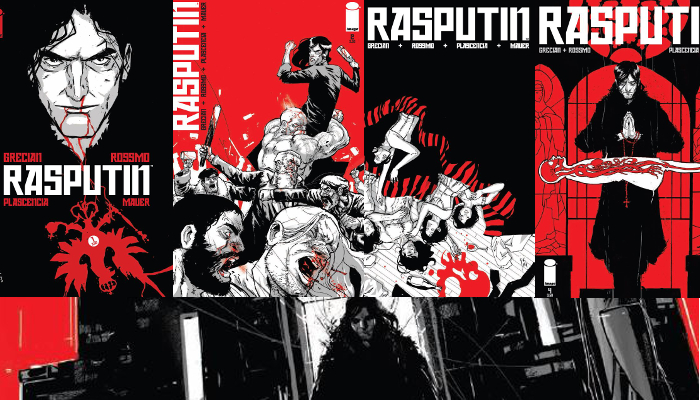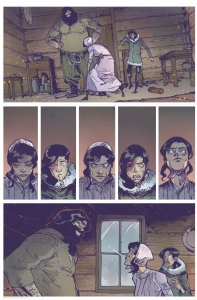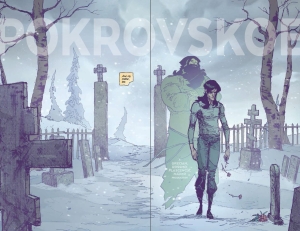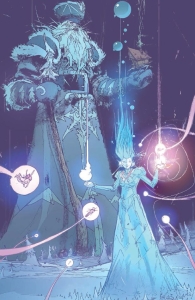REVIEW: RASPUTIN VOLUME 1
IMAGE COMICS
AMBER LOVE 09-APRIL-2015 Certain historical figures get a lot of playtime in our entertainment, whether through fiction or documentaries. One such character is The Mad Monk Rasputin. He’s fascinating, as was his hold over the Russian royal family, which is why people revisit his story time and again. RASPUTIN by Image Comics was created by Alex Grecian (w), Riley Rossmo (a), Ivan Plascencia (c), and Thomas Mauer (l). They do a superb job of blending historical facts with reimagined fantasy and bringing readers a new world of Rasputin to explore. This is only slightly spoilery if you don’t know the basic facts of Rasputin.
Each of the five issues of the first arc focus on moving the main character, Grigori Efimovich Rasputin, from one city to another. The pace of these movements never feels rushed. In issue one, we see Grigori young, perhaps in his late teens/early 20s. He’s still living in a modest cabin with his parents. This is where the story immerses the readers in the depths of Rasputin’s troubled past and the early signs of his supernatural powers.
The real history is that Rasputin has a way of fighting off death. This is addressed in all of the comic issues where a little more information is given each time. In number one, readers are told through Rasputin’s narration right away that he’s being poisoned and willingly consumes the wine handed to him by his so-called friends. This scene breaks off and you’re given the flashback where the “meat†of the issue focuses on Siberia and Rasputin’s relationship with his family. The first scene at the dinner party picks up in issue two at the front and so forth for each issue. The dinner party, or what I’ll say is present time due to his narration, is a brief few pages revisited every chapter.
The pages are quick to turn because there’s a fair amount that are completely wordless or have one word/expression in a caption. Each time location changes, it’s a double-page spread showing the significant venue of the chapter and overlaid with semi-transparent chunky block letters. It’s almost like travel posters with one or two burdened people in the frame warning adventurers where not to go. If you’re reading digitally, double-pages are an inconvenience except in guided view.
Young Grigori is followed by the lumbering ghost of his father from the beginning. You find out who the figure is in issue one. The ghost is almost always too close for comfort. Grigori knows he’s there even when engaged in an intimate drunken orgy. He’s haunted and his powers, you discover by issue four, are more of burden than he tells most people. Few know what he goes through and sacrifices when he heals others. There’s a transference of energies and personalities.
There are significant moments when the colors are the standout element of the panels. The flashbacks are beautifully composited as another time because of Plascencia’s color palette shift. In both the current time and the flashbacks, the colors of winter and all the surrounding pieces of scenes (furniture, clothing, etc.) give an overall neutral background tone. Any element that’s red such as blood or wine or the lime green when the healing powers are in effect, are brighter and luminous.
Issue two continues the style of featuring the present time, flashback, silent pages, high action in one scene, change in location, and a single contained chapter getting to know Grigori more as a person of substance. Where issue one showed Rasputin living through a poison attempt, issue two shows the brutal beating; issue three he’s stabbed; by four, he’s shot; at the end of four, his frenemy sees if Rasputin can survive drowning in icy water. Each issue gives another attempt on his life which he survives keeping the connection to the real story of Rasputin from history. Those aren’t surprises to anyone who has learned about the real Rasputin. What’s clever is that each type of modus operandi is used to give the chapters identity.
Grecian and Rossmo weave in old Russian folklore in issue three and have created a story where Rasputin is the son of Ivan, not the manly ghost attached to him. Ivan is Father Frost (also called Ded Moroz), a supernatural legend who rules the winter kingdom. He’s known for kidnapping children and killing them if ransom isn’t paid. One of those spirit-children becomes attached to Grigori like his father’s ghost. The snow princess, Snegurochka, is in a scene in issue two is where readers see the most otherworldly pages. Because Father Frost created her out of snow and ice near the Tura River, she considers herself Grigori’s sister. But there’s no explanation by this point about why he’s human and she’s not. He tries to heal her, hoping she’d be freed, but the outcome isn’t what he expected.
Another storytelling skill shown is how Rasputin acquires friends slowly. In issue one, he’s isolated and lonely. In two, he’s at a bar and befriends a French man named Dulac. In three, they go to a monastery and the gigantic Brother Makary decides to join their entourage. It’s also where Rasputin decides that from then on, despite his debaucherous ways of life, he gives himself the mantle of a monk.
The closing chapter of this arc is issue five. Grecian/Rossmo set the scene at the Galician border between what is now Poland and Ukraine. I’m not completely certain, but I think the war that is happening in the final issue is the Second Balkan War not WWI. It was one where Rasputin wanted to keep Russia out of the fray. What’s most important is that Rasputin is ordered to the encampment filled with wounded soldiers. He’s willing to use his powers to save a friend, but hesitant to use them on the whole camp because of the transference he experiences. It’s a moment of loyalty to his country that forces him to give in and try to save everyone. His body is weakened and there’s another attempt on his life which brings issue five and the arc to a close. BUT… there are a couple of teaser pages letting you know that Rasputin is not only going to be back for another volume, but the time and location where he’s based might surprise you.
The only thing missing from the first arc is Rasputin having a family other than his parents and the supernatural Father Frost and sister. He was really married and slept around considerably. He officially had seven children, but probably more considering his sexual appetite. None of that is woven into this part. I am curious if the reimagined facts will give him a romantic interest in a modern time and bring children into the story then.
As someone who also creates historical fiction, I enjoy pointing out when things don’t need to be feminist, but still aren’t misogynistic. This is a perfect example of a story being fantastic and failing the Bechdel/MakoMori tests. The closest thing a reader could make to the Mako Mori test in RASPUTIN volume one is the short part that includes the snow princess. Readers get her story of creation and the attempt to free her all within one issue. This is why I’m one that’s often defensive anytime a story is attacked for not including women’s stories. Plenty of times in all our thousands of years of storytelling, the plot is about someone else, who happens to not be a woman; and secondary characters that are women don’t see complete subplots. Even in RASPUTIN, with his known connection (possible love affair) with the Tsarina, that is not discussed. You never see more than a close friendship between them in this version. She only matters in the chapter about the royal family and then the story successfully moves on.
If you appreciate coverage like this review, please consider supporting the website at Patreon.com/amberunmasked.




